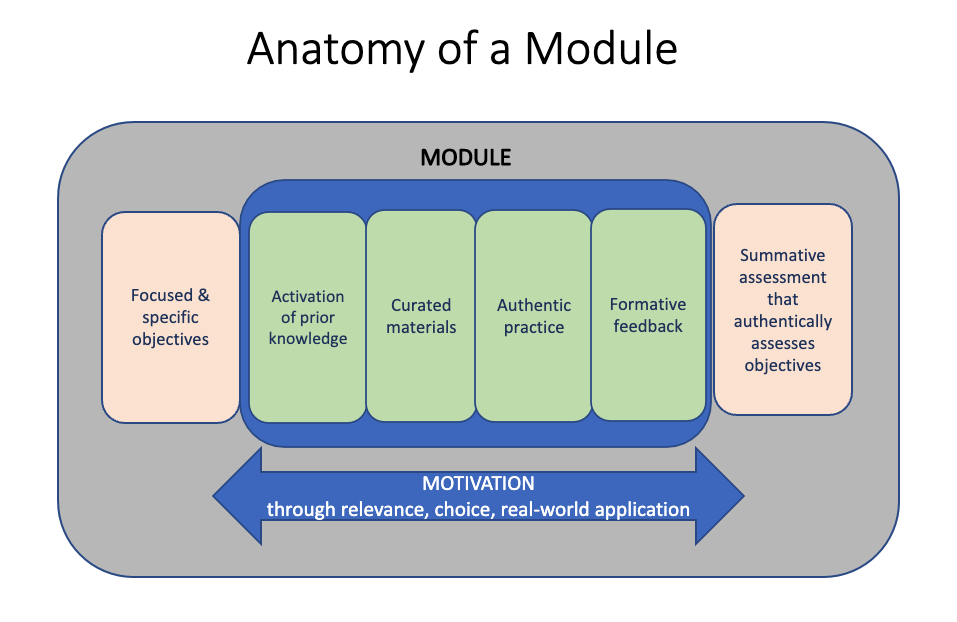Creating Manageable and Flexible Learning Pathways With Modularization
What are modules?
A module is a cohesive and stand-alone unit of learning that has specific start and end points.
Most educators already take a modular approach to teaching. For example, breaking a course down into purposeful “units” or “sessions” helps learners, especially novices, focus attention so they can remember what they are learning better and build their knowledge over time. This process is sometimes referred to as “chunking” (Mayer & Moreno, 2003). Modules include both content and activities designed to help the learners apply and integrate their learning. This diagram provides a visualization of a potential structure for a module of learning.

Students are more likely to get the most out of a module if all the materials and activities are bundled together in an easily accessible space, such as a Canvas course. This makes it possible for them to revisit the materials and activities as often as needed and check their understanding.
Modularization is a process that extends the idea of modules to offer learners flexible pathways while also continuing to engage them in a purposeful learning experience. These pathways may take place within a semester-long course, or they may be offered as a one-credit or non-credit badged experience.
For example:
- In a course, all students complete a sequence of foundational modules and then have the option of selecting from a library of topical modules to pursue a personal interest in more depth. This increases learners’ engagement and creates opportunities for them to share the specialized knowledge they have gained with the rest of the class. Providing students with choice can increase student motivation, and offering multiple ways to demonstrate knowledge creates a more inclusive learning experience (Ambrose et al., 2010; Addy et al., 2021).
- Some skills and concepts are important to many fields (e.g., lab safety, ethical research). Offering one module, or a sequence of shared modules, assures that the orientation and assessment of student learning in a specific area is consistent across multiple contexts.
- Students on co-op may not have the time to take a semester-long course, but they may benefit from a short and timely burst of learning that will be helpful to their work (e.g., learning an in-demand skill or process). What they learn will also be perceived as more relevant because they can see that the skill or process is valued and often used in their place of work.
CATLR Tip
- Examine the syllabi for all the courses you teach. If possible, do this with several colleagues in your department or discipline. Do any concepts or skills span multiple courses? If so, consider how you might collaborate to create one or more modules that could be shared. Note that modules created in Canvas can be easily imported across courses.
- If you develop a module that you think might be valuable to others, consider uploading it to the Canvas Commons so that other Northeastern instructors can benefit from your work.
- Set aside class time to talk with learners about modular resources that would be valuable to them. Perhaps you could partner with them to create one or more modules, or perhaps they could even take responsibility for creating a module for others in the class or even beyond the class.
References:
Addy, T. Dube, D., Mitchell, K. A., & SoRelle, M. E. (2021). What inclusive instructors do: Principles and practices for excellence in college teaching (First edition.). Stylus Publishing, LLC.
Ambrose, S., Bridges, M., DiPietro, M., Lovett, M., & Norman, M. (2010). How learning works: Seven research-based principles for smart teaching (1st ed.). Jossey-Bass.
Mayer, R & Moreno, R. (2003). Nine ways to reduce cognitive load in multimedia learning, Educational Psychologist. 38(1) 43-52. DOI: 10.1207/S15326985EP3801_6
